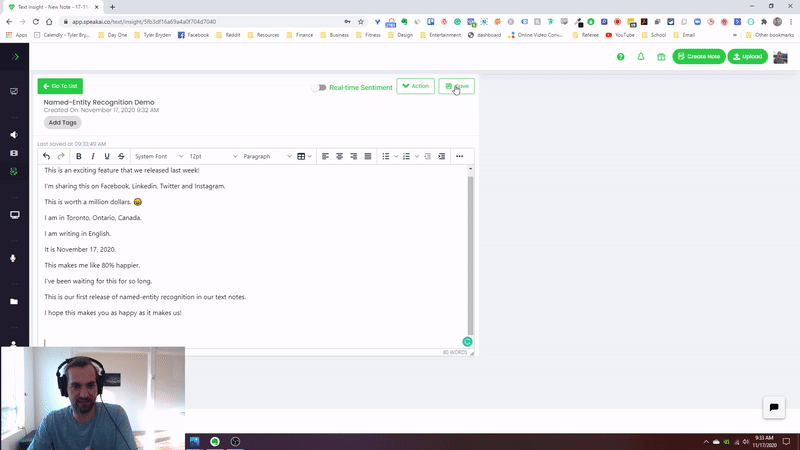
What's New In Speak - April 2024
Interested in What's New In Speak February 2024? Check out this post for all the new updates available for you in Speak today!

A quick little demo from Tyler Bryden on named-entity recognition in Speak Ai text notes!
This unlocks remarkable potential for augmenting your writing experience and surfacing novel insights and patterns over time.
Thank you Vatsal Shah and Timothy Fosteman for your incredible work to bring this to life.
We hope you enjoy! ❤🤗
Data extraction task that is responsible for finding, storing and sorting textual content into default categories such as the names of persons, organizations, locations, expressions of times, quantities, monetary values and percentages.
Example: I am currently living in Toronto although I used to live in London and work every day out of Innovation Works.
We are automatically extracting these categories below. If you want to find other entities in your audio and video, just send us a message and we will build it in for you!
PERSON | People, including fictional. |
NORP | Nationalities or religious or political groups. |
FAC | Buildings, airports, highways, bridges, etc. |
ORG | Companies, agencies, institutions, etc. |
GPE | Countries, cities, states. |
LOC | Non-GPE locations, mountain ranges, bodies of water. |
PRODUCT | Objects, vehicles, foods, etc. (Not services.) |
EVENT | Named hurricanes, battles, wars, sports events, etc. |
WORK_OF_ART | Titles of books, songs, etc. |
LAW | Named documents made into laws. |
LANGUAGE | Any named language. |
DATE | Absolute or relative dates or periods. |
TIME | Times smaller than a day. |
PERCENT | Percentage, including ”%“. |
MONEY | Monetary values, including unit. |
QUANTITY | Measurements, as of weight or distance. |
ORDINAL | “first”, “second”, etc. |
CARDINAL | Numerals that do not fall under another type. |

Interested in What's New In Speak February 2024? Check out this post for all the new updates available for you in Speak today!

Interested in What's New In Speak February 2024? Check out this post for all the new updates available for you in Speak today!
We’re building technology to help you enhance your life.
Take the next step on your journey today.

Powered by Speak Ai Inc. Made in Canada with
Use Speak's powerful AI to transcribe, analyze, automate and produce incredible insights for you and your team.